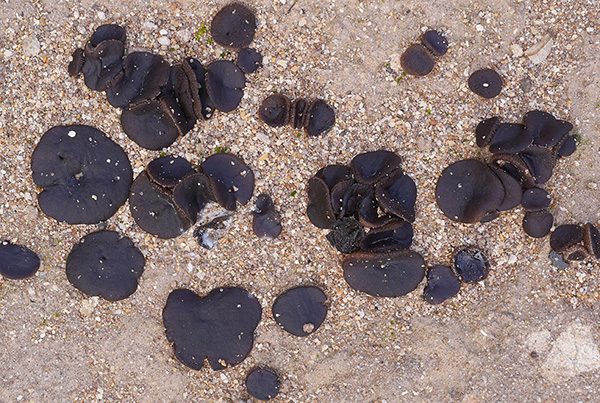Part I. Above-ground fungi

Entoloma ravinense, a new species described in 2016. Photo: D. Catcheside.
The annual surveys of fungi were carried out in the last week of June 2017 by Pam Catcheside (State Herbarium of South Australia), Teresa Lebel (National Herbarium of Victoria), Helen Vonow (Herbarium Collection Manager, State Herbarium of South Australia) and David Catcheside (Flinders University). The group was joined for a few days by Fungimap Co-ordinator Sapphire McMullan-Fisher (National Herbarium of Victoria).

Mutinus cartilaginous (top) and an undescribed species of Leucoagaricus (bottom). Photo: D. Catcheside.
Pam and David Catcheside have been surveying the fungi in Flinders Chase National Park since 2002. Reports on the larger fungi of Kangaroo Island were prepared for the Wildlife Conservation Fund. The fund provided grants to study fungi from South Australia from 1999 to 2005 and specifically to collect data on fungi after fires on Kangaroo Island in 2008 and 2009 (unpublished data). Pam and David have a number of sites in the Chase which are revisited each year. They now have data at these sites for six years before the devastating bushfires of December 2007 and for eight years after those fires.
A dry lead-up to the fieldwork meant that the fungi were not fruiting as much as in previous years. However, some interesting collections were made and some good field photos of some difficult species were taken.
In 2017, the main foci were not only on continuing with making lists of fungi at the different sites visited, but also on disc fungi, truffles and on collecting data for a project on the evolution of truffles. Over 80 specimens were collected, quite a few of which are potentially new or species previously unknown for Kangaroo Island. Details of truffles will be reported in the second part of this blog.

The survey team at work. Photo: H. Vonow.
Over the years, a number of rare and under-collected species of fungi have been found including a new species of a small, white, shell-shaped gilled fungus Entoloma ravinensis P.S.Catches., Vonow & D.E.A.Catches. (1.8mb PDF) This species has previously been collected from one site only in the Ravine des Casoars. A collection was made at a second site at Rocky River, Flinders Chase National Park. The millionth specimen to be databased at the State Herbarium of South Australia was one of this fungus so it has special significance for AD.

Spores of Plicaria species under the light microscope: spiny (left) and alveolate spores (right). Photo: P. Catcheside.
One of the interesting results for this year was a new discovery for South Australia of Mutinus cartilagineus J.H. Willis, one of the Stinkhorns. Stinkhorns produce a mass of evil-smelling, slimy spores on the top of a club-like structure. Flies are attracted by the smell, hence spreading the spores. This collection seems to be the first from the State, though the fungus is relatively common in Victoria and Tasmania.
A good collection was made of an undescribed species of Leucoagaricus, a lovely delicate pale yellow cap with pale apricot coloured lamellae. Further material will be examined from the herbaria in Melbourne and Adelaide in order to make a formal description, and get a better idea of distribution.
A number of small, black disc fungi were collected including three species of Plicaria, two of them probably new and at least two species of Peziza. Most species of Plicaria are early colonisers after fire but one, with spores ornamented with a fine network, known as alveolate spores, was at an unburnt site. Another, with spores ornamented with long spines (see image above) was in vegetation burnt in 2016. One species of was fruiting in long strands in the centre and along the sides of the track leading to Sanderson Bay. The track was of sand and quarried limestone, obviously a suitable substrate for the fungus. Fruit bodies of these disc fungi are very similar in appearance and so microscopic examination of spores and other structures is imperative. Molecular sequencing is often necessary, too.
Part 2 of this blog article can be accessed here.

Peziza growing on a track near Sanderson Bay . Photo: D. Catcheside.
Contributed by State Herbarium Hon. Associate Pam Catcheside.

